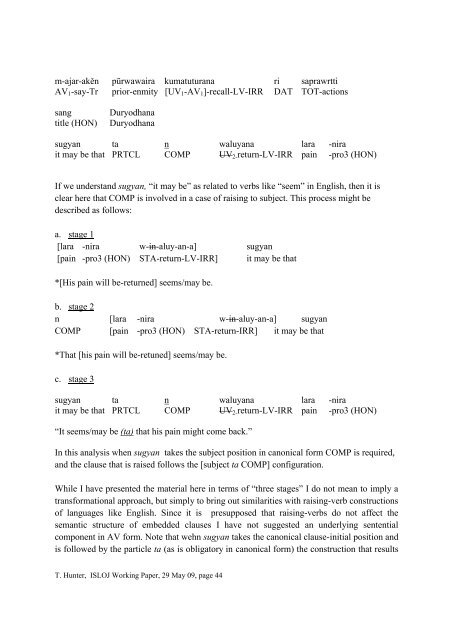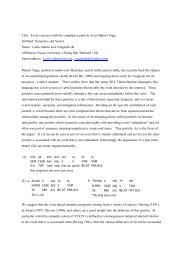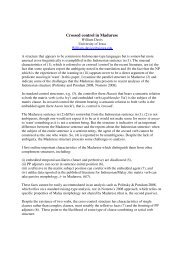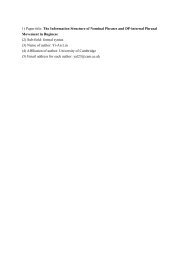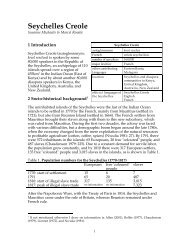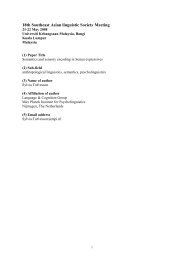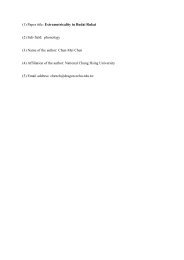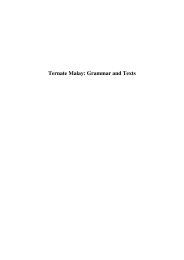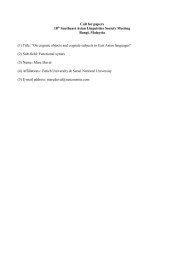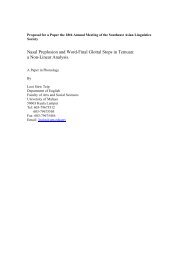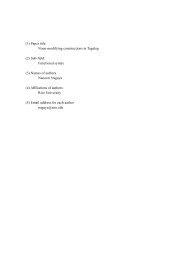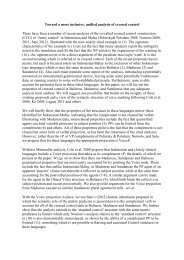Working Paper on Irrealis, Imperative Mode and Complementation ...
Working Paper on Irrealis, Imperative Mode and Complementation ...
Working Paper on Irrealis, Imperative Mode and Complementation ...
Create successful ePaper yourself
Turn your PDF publications into a flip-book with our unique Google optimized e-Paper software.
m-ajar-akěn pūrwawaira kumatuturana ri saprawrtti<br />
AV1-say-Tr prior-enmity [UV1-AV1]-recall-LV-IRR DAT TOT-acti<strong>on</strong>s<br />
sang Duryodhana<br />
title (HON) Duryodhana<br />
sugyan ta n waluyana lara -nira<br />
it may be that PRTCL COMP UV2-return-LV-IRR pain -pro3 (HON)<br />
If we underst<strong>and</strong> sugyan, “it may be” as related to verbs like “seem” in English, then it is<br />
clear here that COMP is involved in a case of raising to subject. This process might be<br />
described as follows:<br />
a. stage 1<br />
[lara -nira w-in-aluy-an-a] sugyan<br />
[pain -pro3 (HON) STA-return-LV-IRR] it may be that<br />
*[His pain will be-returned] seems/may be.<br />
b. stage 2<br />
n [lara -nira w-in-aluy-an-a] sugyan<br />
COMP [pain -pro3 (HON) STA-return-IRR] it may be that<br />
*That [his pain will be-retuned] seems/may be.<br />
c. stage 3<br />
sugyan ta n waluyana lara -nira<br />
it may be that PRTCL COMP UV2-return-LV-IRR pain -pro3 (HON)<br />
“It seems/may be (ta) that his pain might come back.”<br />
In this analysis when sugyan takes the subject positi<strong>on</strong> in can<strong>on</strong>ical form COMP is required,<br />
<strong>and</strong> the clause that is raised follows the [subject ta COMP] c<strong>on</strong>figurati<strong>on</strong>.<br />
While I have presented the material here in terms of “three stages” I do not mean to imply a<br />
transformati<strong>on</strong>al approach, but simply to bring out similarities with raising-verb c<strong>on</strong>structi<strong>on</strong>s<br />
of languages like English. Since it is presupposed that raising-verbs do not affect the<br />
semantic structure of embedded clauses I have not suggested an underlying sentential<br />
comp<strong>on</strong>ent in AV form. Note that wehn sugyan takes the can<strong>on</strong>ical clause-initial positi<strong>on</strong> <strong>and</strong><br />
is followed by the particle ta (as is obligatory in can<strong>on</strong>ical form) the c<strong>on</strong>structi<strong>on</strong> that results<br />
T. Hunter, ISLOJ <str<strong>on</strong>g>Working</str<strong>on</strong>g> <str<strong>on</strong>g>Paper</str<strong>on</strong>g>, 29 May 09, page 44


